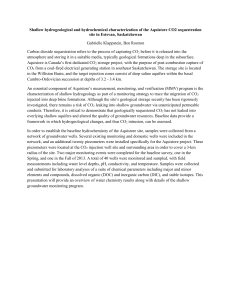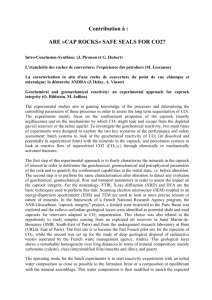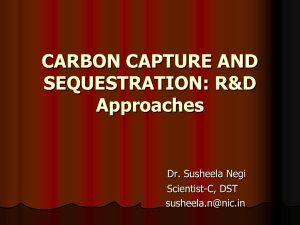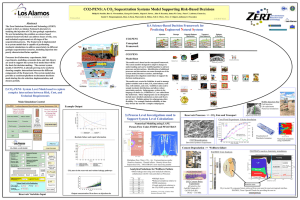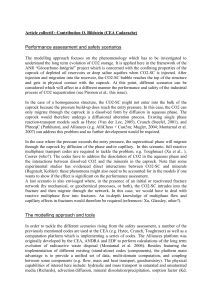Summary Collaborative Research on Carbon Sequestration in
advertisement
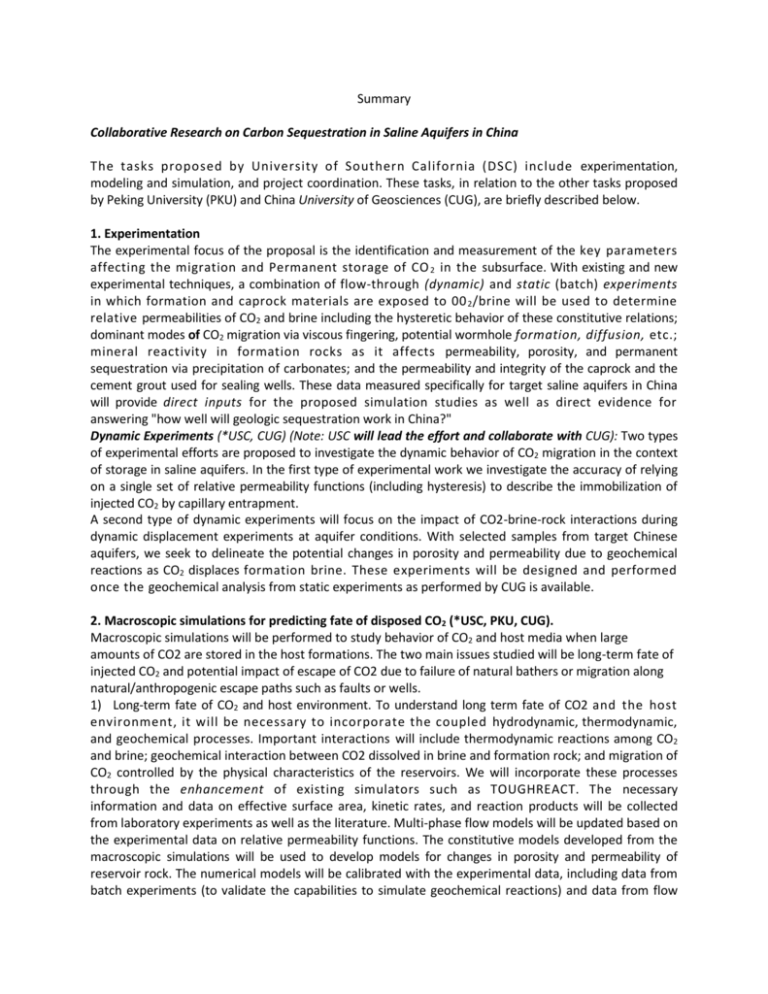
Summary Collaborative Research on Carbon Sequestration in Saline Aquifers in China The tasks proposed by University of Southern California (DSC) include experimentation, modeling and simulation, and project coordination. These tasks, in relation to the other tasks proposed by Peking University (PKU) and China University of Geosciences (CUG), are briefly described below. 1. Experimentation The experimental focus of the proposal is the identification and measurement of the key parameters affecting the migration and Permanent storage of CO 2 in the subsurface. With existing and new experimental techniques, a combination of flow-through (dynamic) and static (batch) experiments in which formation and caprock materials are exposed to 00 2 /brine will be used to determine relative permeabilities of CO2 and brine including the hysteretic behavior of these constitutive relations; dominant modes of CO2 migration via viscous fingering, potential wormhole formation, diffusion, etc.; mineral reactivity in formation rocks as it affects permeability, porosity, and permanent sequestration via precipitation of carbonates; and the permeability and integrity of the caprock and the cement grout used for sealing wells. These data measured specifically for target saline aquifers in China will provide direct inputs for the proposed simulation studies as well as direct evidence for answering "how well will geologic sequestration work in China?" Dynamic Experiments (*USC, CUG) (Note: USC will lead the effort and collaborate with CUG): Two types of experimental efforts are proposed to investigate the dynamic behavior of CO2 migration in the context of storage in saline aquifers. In the first type of experimental work we investigate the accuracy of relying on a single set of relative permeability functions (including hysteresis) to describe the immobilization of injected CO2 by capillary entrapment. A second type of dynamic experiments will focus on the impact of CO2-brine-rock interactions during dynamic displacement experiments at aquifer conditions. With selected samples from target Chinese aquifers, we seek to delineate the potential changes in porosity and permeability due to geochemical reactions as CO2 displaces formation brine. These experiments will be designed and performed once the geochemical analysis from static experiments as performed by CUG is available. 2. Macroscopic simulations for predicting fate of disposed CO2 (*USC, PKU, CUG). Macroscopic simulations will be performed to study behavior of CO2 and host media when large amounts of CO2 are stored in the host formations. The two main issues studied will be long-term fate of injected CO2 and potential impact of escape of CO2 due to failure of natural bathers or migration along natural/anthropogenic escape paths such as faults or wells. 1) Long-term fate of CO2 and host environment. To understand long term fate of CO2 and the host environment, it will be necessary to incorporate the coupled hydrodynamic, thermodynamic, and geochemical processes. Important interactions will include thermodynamic reactions among CO2 and brine; geochemical interaction between CO2 dissolved in brine and formation rock; and migration of CO2 controlled by the physical characteristics of the reservoirs. We will incorporate these processes through the enhancement of existing simulators such as TOUGHREACT. The necessary information and data on effective surface area, kinetic rates, and reaction products will be collected from laboratory experiments as well as the literature. Multi-phase flow models will be updated based on the experimental data on relative permeability functions. The constitutive models developed from the macroscopic simulations will be used to develop models for changes in porosity and permeability of reservoir rock. The numerical models will be calibrated with the experimental data, including data from batch experiments (to validate the capabilities to simulate geochemical reactions) and data from flow through experiments on core samples of reservoir rock (to validate the capabilities to simulate coupled flow and reaction behavior). These simulators will then be used to perform long-term fate calculations. These calculations will be used to perform what-if scenarios, test different hypotheses, and identify areas where additional data/experimental work is needed. 3-D geological models will be established with appropriate data from the selected aquifers. The feasibility of CO2 geological storage will then be investigated, to generate useful insights into additional selection of storage sites and the development of pilot and larger scale projects in China. 2) Impact of escape of CO2 due to failure in aquifer/well integrity or migration through natural/artificial pathways: The results of experiments with caprock and cement will be used to enhance capabilities of the simulators to model the failure scenarios. Experimental data on geochemical interactions between shale and CO2fbrine will be used to develop models for CO2/caprock interactions. Models for transport of CO2 across the caprock including diffusion, flow/reactive transport through variably filled fractures/faults, and geochemical reactions with shales will be incorporated in the simulators. The models will be used to perform analysis of impact of escape of CO2 due to breach in caprock or migration through natural pathways, including the rate and probability of escape to atmosphere. These calculations will be useful in identifying the type of monitoring capabilities required for verification of long-term sequestration as well as evaluation of the risk of CO2 leakage from deep saline aquifers to upper potable aquifers and the effect of the leakage on the groundwater quality. To this end, detailed models of the selected saline aquifers will be used to evaluate the risks of unwanted contamination of other strata. 3. Coordination of Research Efforts Dr. Don Zhang of USC will act as the director for the CUG-PKU-USC collaborative research effort with two deputy directors from China: Dr. Yilian Li. (CUG) and Dr. QiDong Cal (PKU). While the director and the two deputy directors will be in frequent contact, monthly teleconferences/web-conferences will be conducted for the project team to report progress and exchange ideas. Although each of the proposed research tasks is lead by one single organization, the active participation from one or all of the other organizations is fully expected. The research activities will be conducted interactively among the team members either in person or remotely. We will leverage on other programs, such as China Scholarship Council and Fulbright, to enhance mutual visits and exchange of graduate students and young scientists among the three institutes. The graduate students will be jointly supervised by the faculty on the project team. We will hold semi-annual workshops alternating between China and USA. Each of these research workshops will be opened to all project members, GCEP personnel, and invited researchers from China, USA, and elsewhere. The research team will establish and maintain a project web site with both the content accessible to the public and secured content for internal exchange of information and discussion. This collaborative project will bring together Chinese and American scientists and graduate students, which stimulates knowledge and technology transfer. New graduate courses on geological carbon sequestration will be developed and taught by the team members, and a number of seminars will be given in China and USA to report the project research results. These activities will help in building up Chinese and global confidence in geological carbon sequestration as viable option for mitigating global warming. Results of the proposed research will be published in leading technical and policy journals. The graduate students and post-doctoral researchers trained during the course of research will become future research leaders and/or policy makers in the geological carbon sequestration in China.

